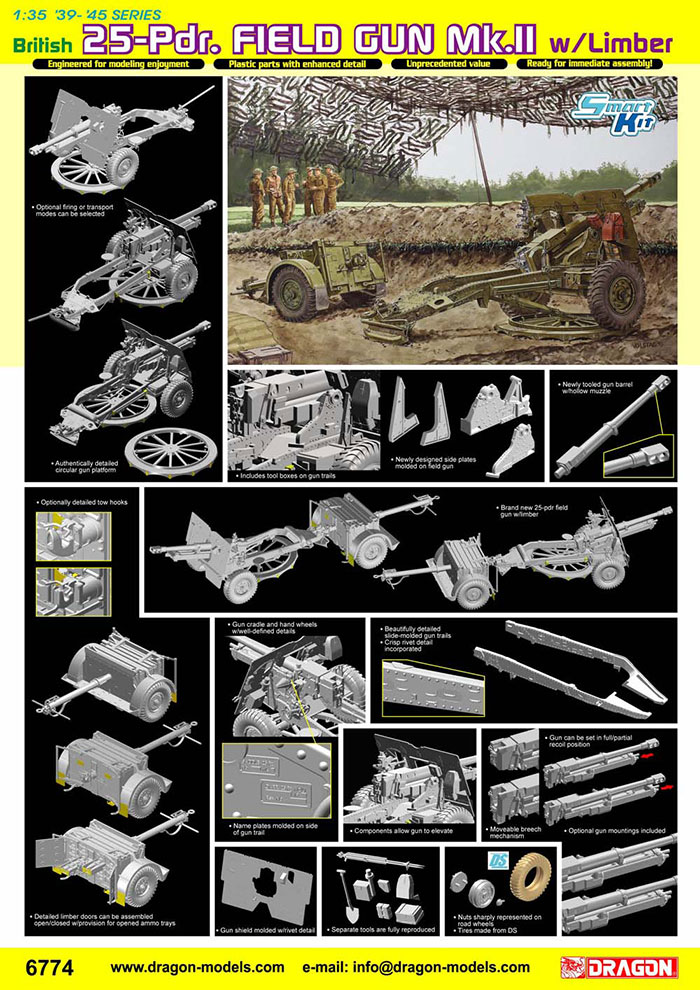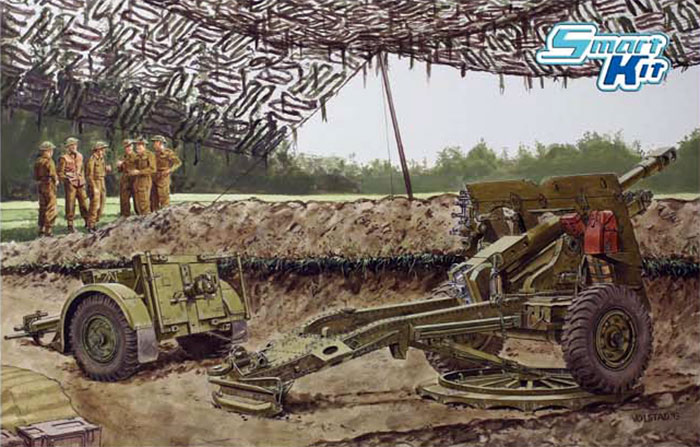|
|
|
|
| Home > Reviews > Britain > Dragon Models Limited 1/35 scale ‘39-‘45 Series Kit No. 6774; British 25-pdr Field Gun Mk. II w/Limber - Smart Kit |
British 25-pdr Field Gun Mk. II w/Limber - Smart Kit
Dragon, 1/35 scale
Reviewed by Cookie Sewell
Summary
| Stock Number and Description | Dragon Models Limited 1/35 scale ‘39-‘45 Series Kit No. 6774; British 25-pdr Field Gun Mk. II w/Limber - Smart Kit |
| Scale: | 1/35 |
| Media and Contents: | 186 parts (161 in grey styrene, 21 etched brass, 4 DS Plastic tires) |
| Price: | pre-order price US$41.95 via Dragon USA Online |
| Review Type: | First Look |
| Advantages: | Use of modern molding techniques makes for a more faithful representative of this weapon; several construction and build options provided |
| Disadvantages: | No ammunition! |
| Recommendation: | Highly Recommended for all “gonners” and WWII Commonwealth fans |
FirstLook
As I noted with the first version of this kit (No. 6675) a new gun was developed after WWI which became the famous 25 pounder. While its design had started in 1925, due to the efficiency (and prevalence) of the 18 pounder it was not until 1935 it was fielded. To save money during that time, the new barrels were mounted on redundant 18-pdr carriages as the Ordnance QF (quick firing) 25 pdr Mark I.
But due to the design of the lower carriage, the gun could not be elevated high enough to get full use out of its capabilities. So a new carriage with box trails and a large opening between them (which would permit sufficient elevation and traverse) was designed, combined with a special platform that would permit 360 degree rotation within a set position. This became known as the Ordnance QF 25-pdr Mark II on Carriage 25-pdr Mark I.
This wound up being the mainstay gun of the Royal Artillery during WWII and into Korea and beyond. More than 12,000 were built, and they were used in all theaters of operations. Later, when it demonstrated some capability as an antitank gun, a double baffle muzzle brake was fitted to cope with the increased charge and recoil.
It was normally coupled to the Artillery Trailer No. 27 Mark I or later models. This limber, in its 25-pdr version, provided stowage of up to 32 rounds of ready ammunition in two round trays. While the ammunition was nominally separate loading, it could be stuck together just before firing. Crew of the gun was five or six: one aimer, three or four other numbers for ammunition, and a gun captain.

DML now offers the later version of the Mark II gun with its unique square two-baffle muzzle brake and other detail changes to the upper carriage; they replaced a sprue of 21 parts with two sprues of 32 parts. While it still includes the No. 27 trailer (limber) it no longer comes with a crew, but oddly enough now retails for $2 more than the original kit. As previously citedit was based on pieces on display at “Firepower”, the Royal Artillery Museum at Woolich. From what I can tell from comparing the photos to the 1/1 scale example, DML appears to have hit all the marks.
The gun itself now comes on four sprues: the gun, the recoiling section, the shield and upper carriage, and the lower carriage (trails) and base elements and wheels. All show evidence of intensive use of slide molding to capture both inner and outer details. The gun proper now consists of nine parts (all styrene). The breechblock can be position opened or closed; however the activation lever (C3) is only shown in one position. It was noted that there is no breech inside the block for projectiles to load in so any use of ammunition will not be able to have anything in the breech itself. The cradle offers a choice between early production riveted components (C22/C23) or welded ones (C20/C21). The warning instructions brass plate is present but alas, not readable (but then again I had to get within three feet of it to read it on the prototype!)
The lower carriage and wheels are nicely detailed, and the complex shapes of the prototype are captured. The only thing missing from the kit here is the coil of rope that was to be hung off the front of the gun shield. Gun spikes (B21/23), the shovel (B18), a spare rammer (A13) and mattock (A26) are provided. Note the upper gun shield can also be shown up or folded; the gun shield itself is molded credibly thin and free from ejection pin marks.
Steps 5 and 6 are an either/or proposition, as they cover firing and transport modes for the gun. In “Firing” part A16 is used to attach to the rotating base (A17/48) and in “travel” part A15 is used. Part A4 is interesting; it is the spade protector which is used when the gun is fired from its platform so the gun can swivel around the platform without digging in. It is shown in position in Step 5 and stowed in Step 6; note if the gun is fired without using the platform the protector is left stowed so the spade can function. Also note in Step 5 that the items in the cutaway (MA6/7) are apparently mounts for aiming stakes (not provided) that go on the outside of the right side of the box trail; DML’s directions tend to not be as helpful as they could be with parts like this.
Steps 6-11 cover the assembly of the No. 27 trailer. This also has some options such as open or closed doors, two removable trays with brass details, and two different styles of hitch to connect to the gun lunette. The wheels even come with separate handbrakes and activating arms. But unlike the original kit which had three rounds for the gunners to handle there is NO ammunition provided with this kit, which is a bit of a shame (don’t believe the box claim!).
The tires are DS Plastic – seamless and of the right pattern when matched with photos. The injection nub is on the inside of the rim and should vanish behind the wheel rim when installed.
No decals are provided. Painting directions give two options: Unidentified Unit, North Africa 1943 (sand overall); Unidentified Unit, England 1943 (no color shade given but standard British green should be the shade).
However, based on the “Firepower” guns (an early Mark II sans muzzle brake and the last one in service with the British Army) – lovingly restored to near original finish - there are a lot of details which need painting and are not called out. Most of the leather bags appear dark brown, the seat is varnished wood, as are the rammer and mattock and shovel handles, and the sights are either natural metal or black. DML needs to pay more attention to painting details.
Overall this is a nice kit but has been compared with a similar effort from Bronco. Consensus is the Bronco kit has more details and a better No. 27 – but is a bit of a handful as it has a lot more parts and three frets of etched brass. The DML one is a very good effort – and much easier to build.
Sprue Layout:
A 1 Body
B 75 Undercarriage, seats, hood, engine
B 1 Underframe
C 17 Combat wheels and tires, grille, brake drums
C 8x2 3 x Vickers K machine guns and drums
C 3 Sun compass
D 4 Clear styrene
E 15X2 Civilian style wheels and tires
F 40x2 US Generic - “Jerry” cans
N 12 German Generic - “Jerry” cans
MA 63 Etched brass
MB 2 Etched brass
– 13x2 SAS Commander figure
Thanks to Freddie Leung for the review sample.


